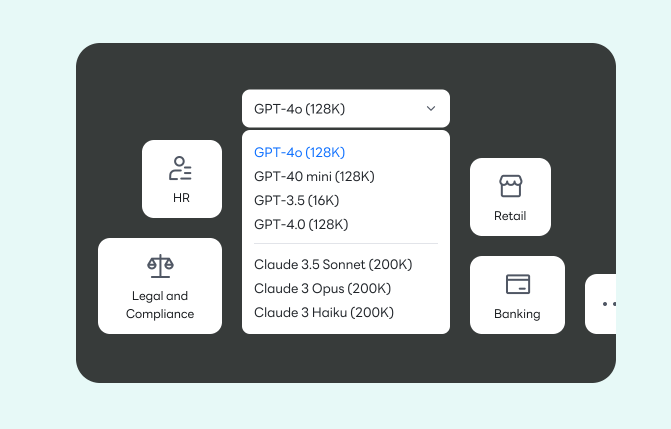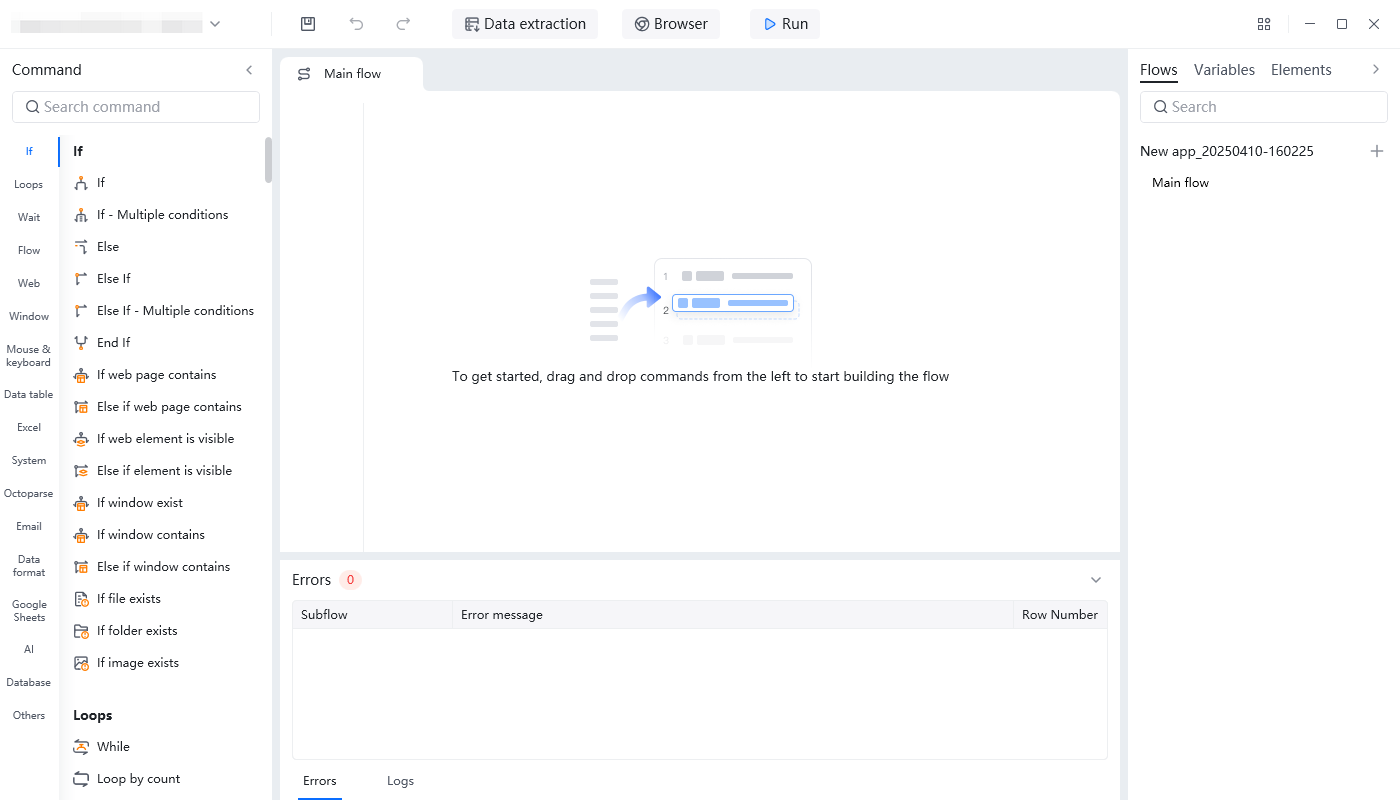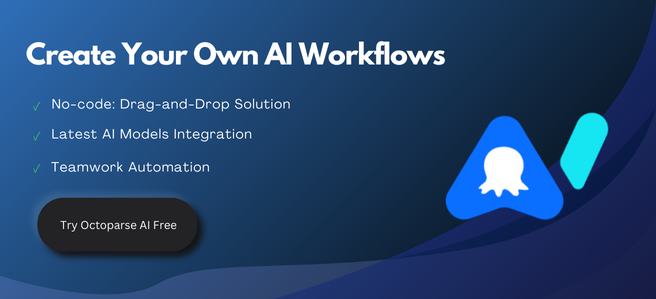Knowing the distinction between traditional automation and robotic process automation (RPA) is crucial as companies embrace digital transformation. RPA offers greater flexibility and quicker deployment by simulating human actions on user interfaces. It’s especially helpful for managing unstructured data from desktop programs and websites. Conversely, backend coding, API integrations, and rigorous rule-based logic are key components of traditional automation. While it performs well in stable, structured environments, it can be slow to implement, difficult to adjust, and expensive to maintain—especially when dealing with dynamic web content.
By merely stating their needs in simple terms, users can use Octoparse AI to extract data from websites. It suffices to say, for instance, “Scrape all laptop prices and reviews from this e-commerce site.” Without the need for XPath, scripting, or coding, the AI evaluates the page structure, creates the scraping logic, and starts the task. It greatly reduces the barrier to automation by providing a visual interface, natural language commands, and AI-powered page recognition.
What Is RPA And Traditional Automation
Traditional Automation has been a cornerstone of enterprise IT for decades. It relies on backend system integrations, typically through application programming interfaces (APIs), database connections, or scripting. This approach requires:
- Direct access to system architectures
- Structured data formats
- Significant upfront development effort
- Ongoing IT maintenance
Traditional solutions excel in environments where processes are stable, volumes are high, and systems can be modified—such, such as ERP or banking transaction systems.
RPA, in contrast, operates at the user interface level, mimicking human actions like clicking, typing, and data entry. Its distinguishing features include:
- No need for deep system integration
- Ability to work with both structured and unstructured data
- Rapid deployment (often in days or weeks)
- Minimal coding requirements
This makes RPA particularly valuable for legacy systems where API access is unavailable or for processes that span multiple applications.
Technical Comparison of RPA And Traditional Automation
Integration Approach
Traditional automation requires direct system integration, demanding:
- API development
- Database schema modifications
- Middleware implementation
RPA tools like Octoparse AI, UiPath, or Automation Anywhere interact with systems through their UI, enabling automation without backend changes. For example, Octoparse AI specializes in web data extraction, using intelligent element recognition to adapt to dynamic web pages—a task challenging for traditional methods.

Adaptability
Traditional solutions struggle with process changes, often requiring:
- Code revisions
- Retesting
- System redeployment
RPA platforms offer greater flexibility. Octoparse AI, for instance, uses machine learning to adjust to webpage layout changes automatically, reducing maintenance overhead.
Development Complexity
Traditional automation demands skilled developers proficient in:
- Programming languages (Python, Java, etc.)
- System architecture
- Data engineering

RPA tools provide low-code/no-code interfaces, enabling business users to build automations. However, advanced RPA platforms like Octoparse AI also support complex scripting for intricate workflows.
Practical Applications
Where Traditional Automation Excels
- High-volume transaction processing (e.g., bank payment clearing)
- Core system operations (e.g., inventory management in ERP)
- Stable, long-term processes with infrequent changes
Where RPA Shines
- Legacy system automation (e.g., mainframe green-screen applications)
- Cross-application workflows (e.g., data transfer between CRM and Excel)
- Quick-fix solutions for departments lacking IT support
For web-specific tasks, Octoparse AI outperforms general RPA tools in:
- Dynamic web data extraction
- Handling JavaScript-heavy pages
- Adapting to website redesigns
Meanwhile, enterprise RPA platforms like UiPath offer broader capabilities for:
- End-to-end process orchestration
- Centralized bot management
- Advanced exception handling
Cost and Maintenance Considerations
Implementation Costs
- Traditional automation requires higher initial investment in:
- Development resources
- System modifications
- Testing infrastructure
- RPA typically has lower upfront costs but may incur:
- License fees for commercial platforms
- Training expenses
- Ongoing bot maintenance
Long-Term Maintenance
Traditional systems, once implemented, often run for years with minimal changes. RPA solutions, while quicker to deploy, may need more frequent updates—especially when dealing with UI changes. However, modern RPA tools like Octoparse AI mitigate this through:
- Self-learning element selectors
- Change detection alerts
- Version control for workflows
The Future: Convergence and AI Enhancement
The line between RPA and traditional automation is blurring as:
- RPA platforms incorporate API capabilities (e.g., UiPath Integration Service)
- Traditional systems adopt RPA-like flexibility through microservices
AI is transforming both paradigms:
- In RPA: Octoparse AI uses machine learning for intelligent data extraction, while tools like Automation Anywhere integrate NLP for document processing.
- In Traditional Automation: AI/ML models are being embedded directly into core systems for predictive maintenance and decision automation.
For businesses, this convergence means hybrid approaches are becoming viable—using RPA for front-end agility while leveraging traditional automation for backend robustness.
Choosing the Right Solution for Your Business
Selecting between RPA and traditional automation depends on:
| Factor | Traditional Automation | RPA |
| Implementation Speed | Slow (months) | Fast (days/weeks) |
| IT Dependency | High | Low (for basic workflows) |
| Change Flexibility | Low | High |
| Best For | Core system integrations | Departmental/legacy tasks |
Recommendations:
- Use traditional automation for:
- Mission-critical, high-volume processes
- Systems with stable interfaces
- Choose RPA (like Octoparse AI for web tasks or UiPath for enterprise workflows) when:
- Quick deployment is essential
- Working with inflexible legacy systems
- Processes span multiple applications
For web data projects specifically, Octoparse AI’s balance of no-code usability and intelligent adaptation makes it a standout choice over general RPA tools requiring complex setup for similar tasks.
Conclusion
RPA has established a crucial niche, especially in bridging system gaps and empowering non-technical users, even though traditional automation is still essential for core system integrations. For certain use cases (like web data extraction), specialized RPA solutions can perform better than general platforms, as shown by tools like Octoparse AI, while enterprise RPA suites keep growing in functionality.
The best strategy frequently blends the two technologies: depending on conventional techniques for backend stability and RPA for agile, front-end automation. Organizations that strategically combine these approaches will have the biggest competitive advantage in the automation era as AI continues to improve both paradigms.
Businesses no longer need to rely on development teams thanks to Octoparse AI, which also speeds up implementation and makes real-time data access simpler than before. It is intelligent, flexible, and genuinely no-code, and it is the next step up from RPA. Octoparse AI reimagines what is feasible with data-driven automation—without the conventional complexity—as businesses strive for quicker insights and increased agility.
